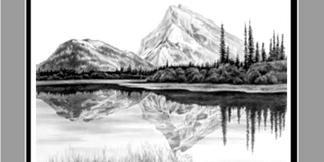 Whatever your level of skill, these tips will help guide you in developing habits that will grow your abilities to draw and paint landscape scenery with just a couple of weeks of consistent practice.
Whatever your level of skill, these tips will help guide you in developing habits that will grow your abilities to draw and paint landscape scenery with just a couple of weeks of consistent practice.
Implement these for 15 or 20 minutes a day and the improvements will be greatly evident.
Tip No. 1 – Quick Impression Drawings
Get out of the house! Go to the zoo, the museum, a park, an apartment building complex, somewhere other than where you typically draw. Focus on drawing moving things. Drawing objects in motion will help you develop the flow. Every experienced artist can tell you about the flow. Your speed of drawing will increase by practicing these quick impression sketches, but will also help you to develop your perspective drawing skills and build up a repertoire of animals, objects, and people that you can readily access from your mental toolbox.
Tip No. 2 – Blind Drawing
This method is mentioned in all major drawing instruction books and often goes unnoticed or ignored by most artists. This method (also known as “blind contour drawing”) requires that the artist follow its subject with his/her eyes and not focus on the paper they are drawing on. This technique is a great way to keep your drawings vivid and has been dubbed the ultimate anti-stiffening tool in a professional artists bag of tricks.
Tip No. 3 Forget the eraser!
“Do not fear mistakes. There are none.” – Miles Davis
Every line you draw is a representation of your own handwrite. This is the unique signature of your artistic expression. Do you really want to erase that? Practice making every line work for you.
Tip No. 4 Take measurements!
One of the largest sources of complaints of growing artists is that their proportions are off. You don’t need to get fancy here. Use your pencil or other small stick, extend your arm as far as it will go (in order to ensure accuracy for each measurement), and note with your eyes how much of the length of your stick that particular object runs. Drawing roofs, chimneys, beaches, trees, animals, and many other things become much easier to make proportionate when you implement this small technique.
Tip No. 5 – Draw negative space
When you see a bale of hay, a fishing net, or long strands of hair, are you trying to individually draw the lines in the net, the fence, or the hair? Try implementing this technique and draw the negative space and see what objects it works best on. It’s a nifty trick that, when mastered, provides a faster, easier, and better looking drawing of more intricate items.
So grab your pad and pencil and practice, practice, practice! After all, this is the one surefire way to improve!
Be an Artist in 2 minutes with Segmation SegPlay® PC (see more details here)
SegPlay® Mobile iTunes now available for iPhone and iTouch
Related articles
- Do a Blind Contour Drawing (education.com)
- Exercise 16: Observing negative space and perspective (rlangham.wordpress.com)
- Inspiration Station: Tree Drawings by Tim Knowles (fthats.wordpress.com)







These tips will help me out a lot 😀 great post
i am an artist who’s had a block for many years, but what u r teaching here, is the right path. thanks for sharing.
Hi there! This blog post could not be written much better!
Going through this article reminds me of my
previous roommate! He always kept preaching about this.
I’ll forward this post to him. Pretty sure he will have a good read. Thanks for sharing!
Pierre, Thanks for your comments. You have an awesome blog! http://www.segmation.wordpress.com
thanks for the drawing tips. i used to do quite a bit of cartooning, and would like to get back into it. thanks also for liking my blog. may the muse be with you!
So helpful! I’m always overwhelmed by landscape. It’s so large, and I have trouble deciding what to focus on. I guess that’s why I’m better at close-ups and focusing on details of smaller things. I saved your article in my “class” online folder for future use. Great stuff!
I’m not an artist but really enjoyed these tips, esp about not having an eraser, I would have thought that’d be essential.
Great tips! I’m starting to draw again, and learning to paint with pastels, so your tips are timely.
A water feature can be beautiful and calming in any size of landscape. Get inspired with alluring ponds and fountains, find surefire water garden plants, and take a tour through a fantastic water garden makeover.
Joseph@MasonryContractorssandiego
First time here. This is very helpful information. Thank you